Scarcity

Scarcity in marketing means using the fear of limited supply to sell more.
Scarcity can also increase the perceived value of the item or service you're providing.
1962
shares
Brainiac

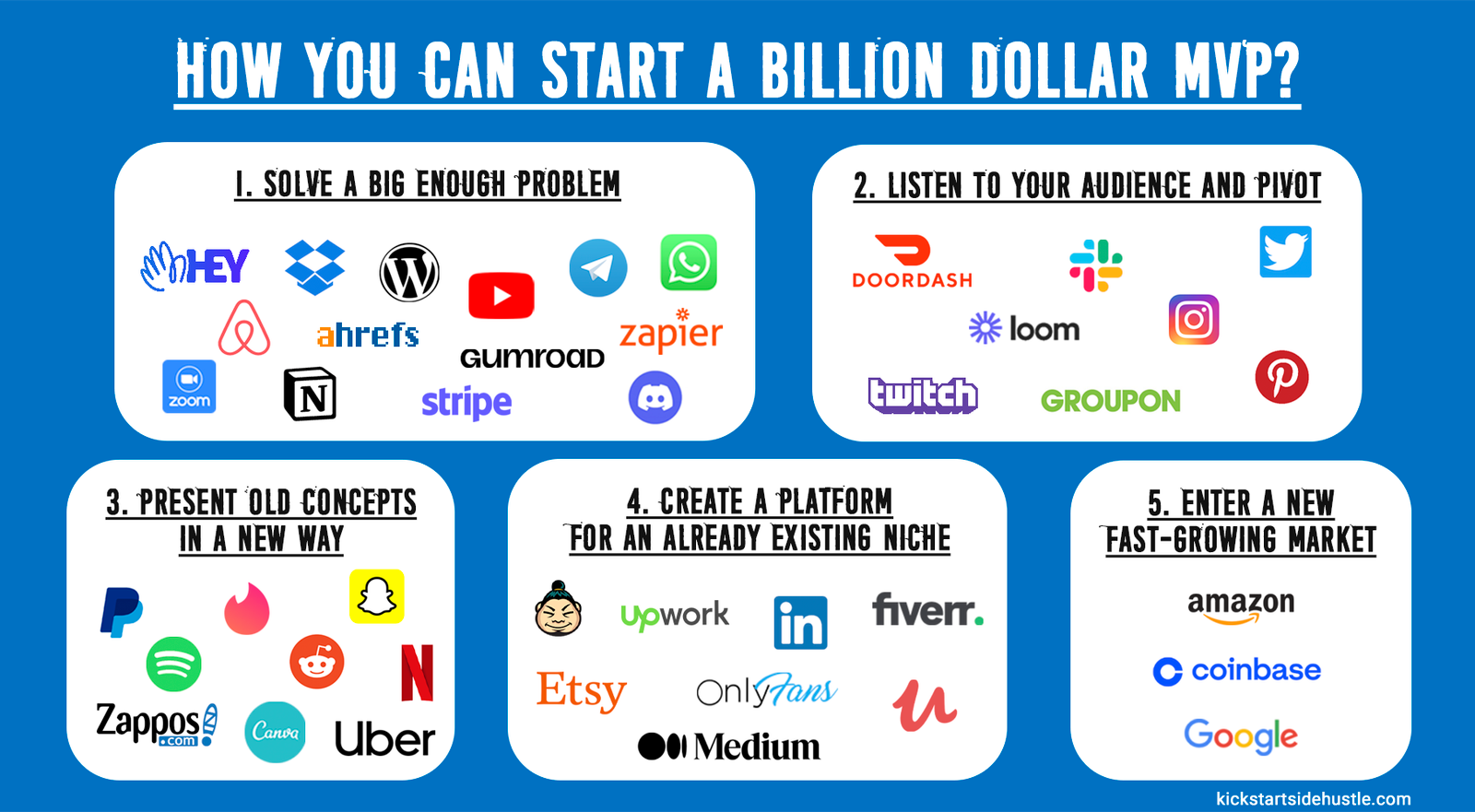
In this not-so-short article, we will dive deep into the subject of how billion dollar companies developed their MVPs and got their first 1,000 customers.
Among the 42 companies listed below, I have distilled the 4 main marketing strategies with 13 sub strategies in total. Many businesses used a few of those strategies at once.
The core messages are:
----------------
*We could have "dive deeper" into each case:
but this page would be hundreds of pages long - it already includes more than 65 A4 pages of content - you could argue, it already contains more "meat" content than many renown books.
You can find the "dive deeper" insights here
Viral effect takes place when the product or service needs at least 2 people to work. People naturally invite their friends to use it and interact with each other through the platform.
Think about messaging platforms & social media apps.
These products either:
Invite-only strategy at the very early stage is quite common among many succesful startups. In order to make it work, businesses need to create a sufficient enough hype around the platform.
Niching down and creating a lot of publicity around it (usually thanks to having influencers on your platform early on) seems to work best.
Scarcity + Authority Bias = FOMO
Subscribe to receive similar content with even deeper insights
How do you describe a big enough problem?
It's a problem that thousands of people are already actively searching a solution for.
You can verify it through the Google's search volume, forums, and negative customers' reviews on a popular products or services.


Brian Chesky and Joe Gebbia, two roommates from San Francisco, struggled with paying for the rent. They thought they could earn some cash by renting their apartment for a night. They bought 3 air mattresses and set up a page. They got 3 customers ($80/night each) when a big conference was going on in San Francisco, and the hotels were out of free rooms. They called their website AirBed&Breakfast. When Nathan Blecharczyk joined the team, their project became a website with hosts offering their places for booking a stay.
Guys went to Craigslist. They manually searched there for room-renting offers and wrote emails to their authors. They asked them to include AirBed&Breakfast in their posts. They got into Paul Graham's Y Combinator and changed their logo and their name (Airbnb).
They also “hacked” Craigslist. They coded a bot that looked for room-renting offers itself, and then sent emails.
When they got short on money, they released Obama O's and Cap'n McCain's cereals.
Within a week Obama O's & Cap’n McCain's sold $30k worth of cereals - almost 4 times what the Airbnb core business had made before this moment.
To improve UX, they visited their hosts to take high-quality photos of the rooms, and then they put them on Craigslist with a positive opinion. Soon, Chesky, Gebbia, and Blecharczyk got investors.
Dropbox was born on a bus trip. It's an idea for a remote storage system, available from any place through the Internet. Drew Houston often forgot his USB disks, so needed some workaround.
He thought that he could solve his own problem by himself. He wrote the code, but before he launched Dropbox, he made a short video. It was a presentation of Dropbox’s capabilities, with Drew’s voice commenting on what he was doing on-screen. He uploaded it along with a waitlist to Hacker News and Digg (Reddit’s predecessor).
The video got 70k first signups the waitlist next day, mainly thanks to the inside jokes of the Digg’s community that he included.
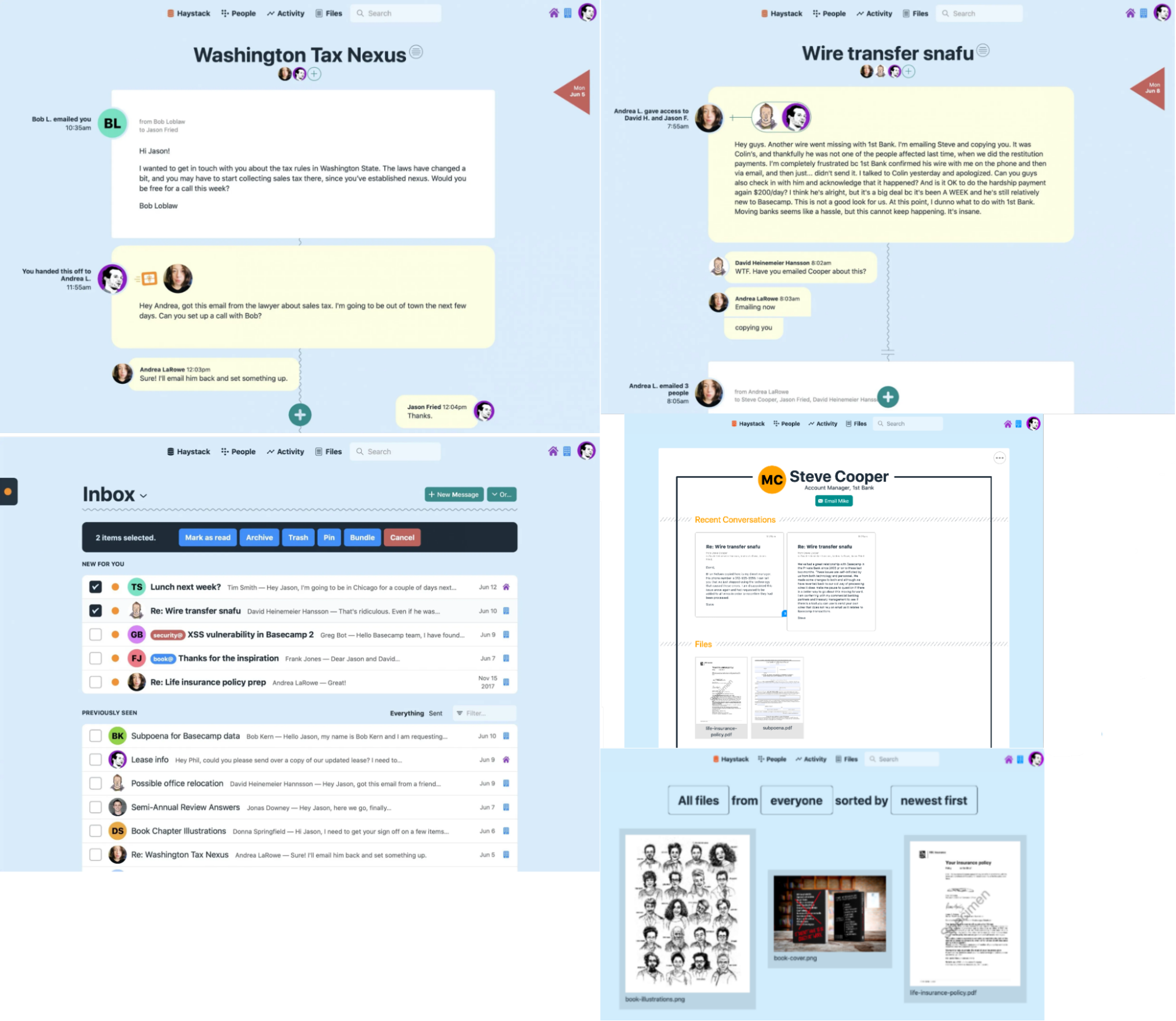
Basecamp’s team struggled with spamming emails in their company. They had Highrise, a software for team communication and task-managing. They didn’t have anything for “external” communication.
They started to work on Haystack. It was a prototype for work communication purposes, like contacting the press, receiving app notifications - everything that was a pain in the ass of the Basecamp’s team members.
Haystack was built on the basis of Highrise. They tested it on their own conversations and threads. Later, they changed the project name to HEY, and continued to polish the app.
The founders tweeted a lot about HEY email. Both Jason Fried and David Heinemeier Hansson had quite powerful personal brands on Twitter, totaling of combined 640,000 followers, which they could capitalize on when promoting new email app. Since it fits perfectly what they’d been preaching before, many of their followers wanted to try it out.
Then they created an invite-only waitlist. A week since the app’s launch, more than 100,000 people have already signed up.

WhatsApp was founded by Jan Koum and Brain Acton. Koum attended Alex Fishman’s regular meetings at his place. Local Russians often came to Alex for pizza and movies. Koum pitched WhatsApp to them. He hated it when he missed a call, so he wanted to make an app that would show people’s statuses when they couldn’t talk on the phone (e.g. “Low battery”).
WhatsApp 1.0 had bugs and people didn't like it much. When Apple announced push notifications for iOS, Koum decided to launch WhatsApp 2.0, integrated with that feature. Now, people could get notified when their friends would change their status.
Koum and Acton also took advantage of an App Store's bug. The “What's New” list saw WhatsApp as a “new” app whenever the creators changed its name on AppStore. They kept changing it, and it gave them the first 1,000 users because WhatsApp stayed at the top of the “What's New” list until Apple fixed that bug.
Soon, people started using WhatsApp for instant messaging, and it sparked an increase in WhatsApp’s popularity.
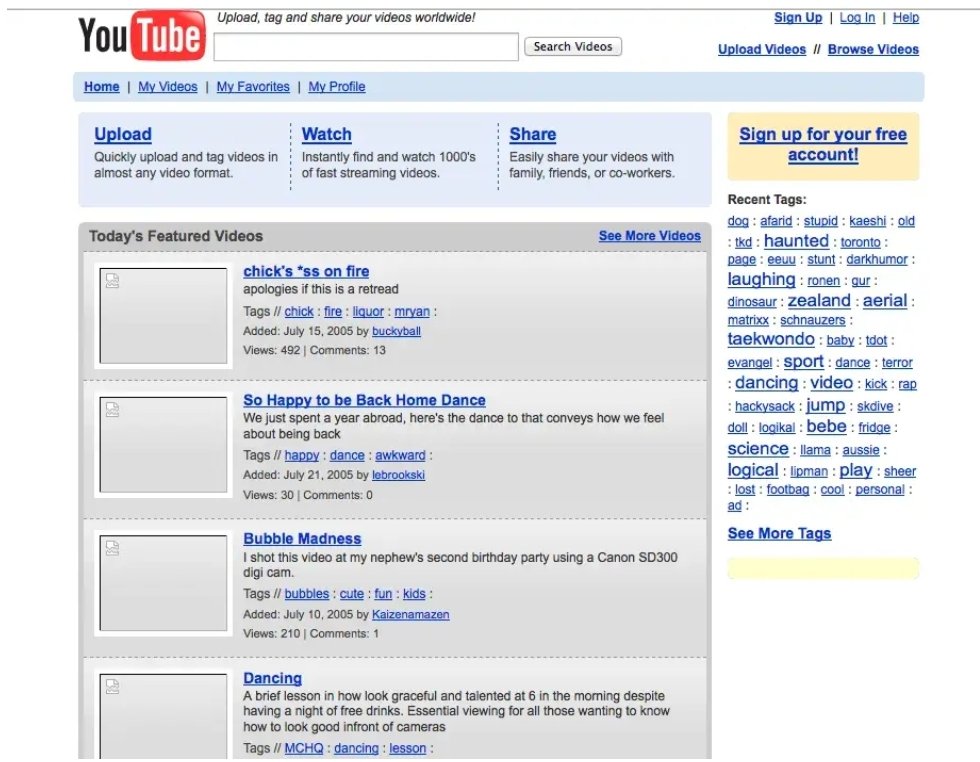
Chad Hurley, Steve Chen, and Jawed Karim, the Youtube founders, had all been former PayPal employees.
YouTube started as a platform for sharing videos for dating purposes. They wanted to share a video, but they couldn't find an appropriate place for it on the Internet. A dating YouTube wasn't popular. People started uploading amateur videos about other stuff, not related to dating.
The founders listened to their users and transformed YouTube into the all-kind free, video-sharing platform where each video had its own unique link. Back then, online video was quite buggy. Youtube solved this problem by introducing a flash-based, one-click videos.
YouTube got their first users by piggybacking on Myspace. Musicians on Myspace (the main Myspace's user base) wanted to show their music videos. YouTube provided a solution to that.
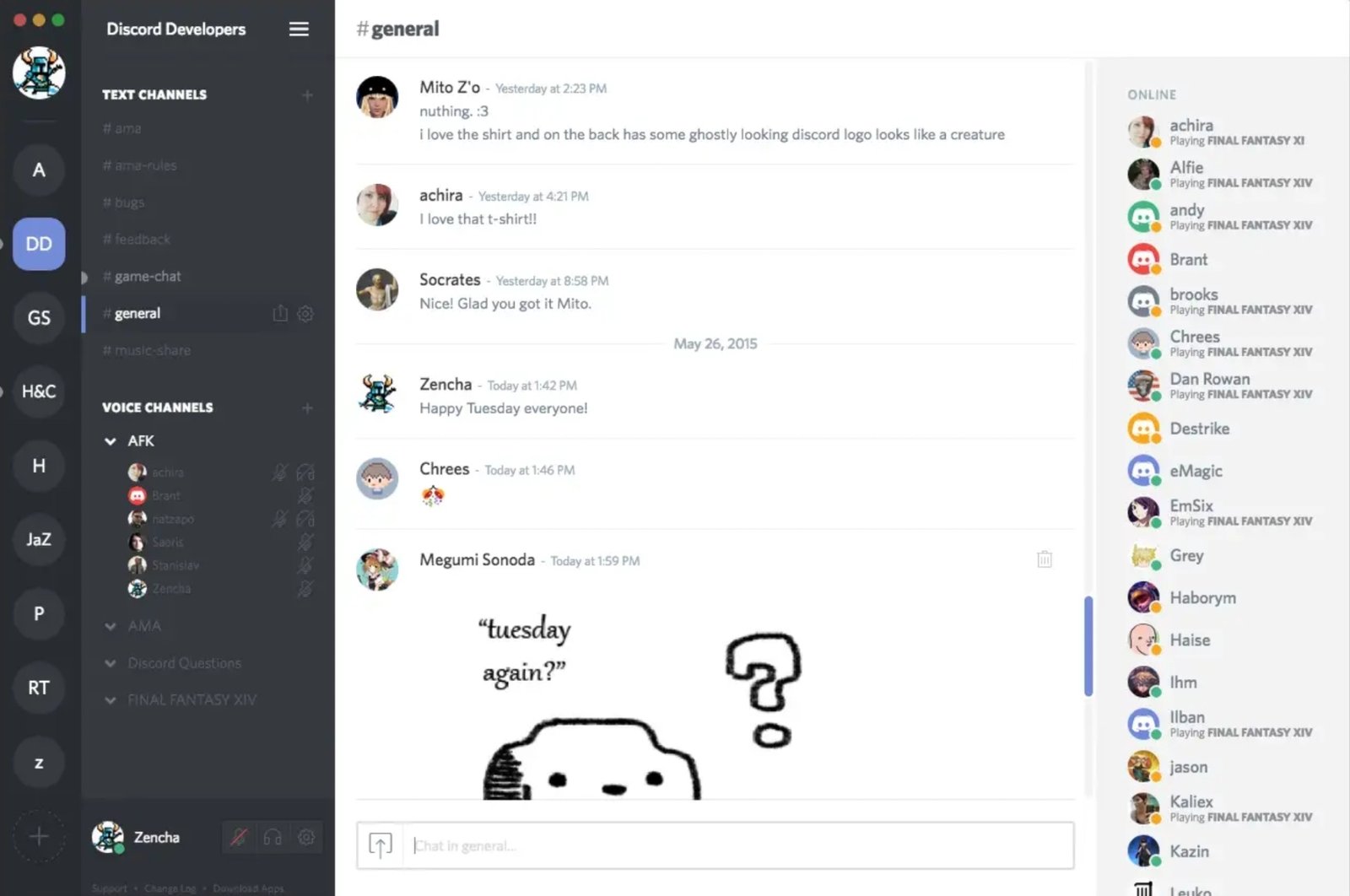
Jason Citron and Stan Vishnevskiy loved video games. Citron had been making games, but they weren't popular enough. Together with Vishnevskiy, they wanted to build something for better and smoother social connections between players. One good thing about Citron’s games was their chatting systems. The guys decided to make use of that knowledge.
There was no simple tool for communication in games. TeamSpeak and Skype had issues with their voice chat. Citron and Vishnevskiy came up with Discord.
It wasn’t too popular until the launch of one expansion pack to Final Fantasy XIV. Some Redditor posted a link to Discord on the subreddit about FF XIV. Jason and Stan noticed it and jumped in to voice-chat with the newcomers.
People thought they were “cool” and went back to that subreddit to tell others to come and talk to the Discord founders. Discord got a surge of new users, and it’s been just a snowball effect since that day.
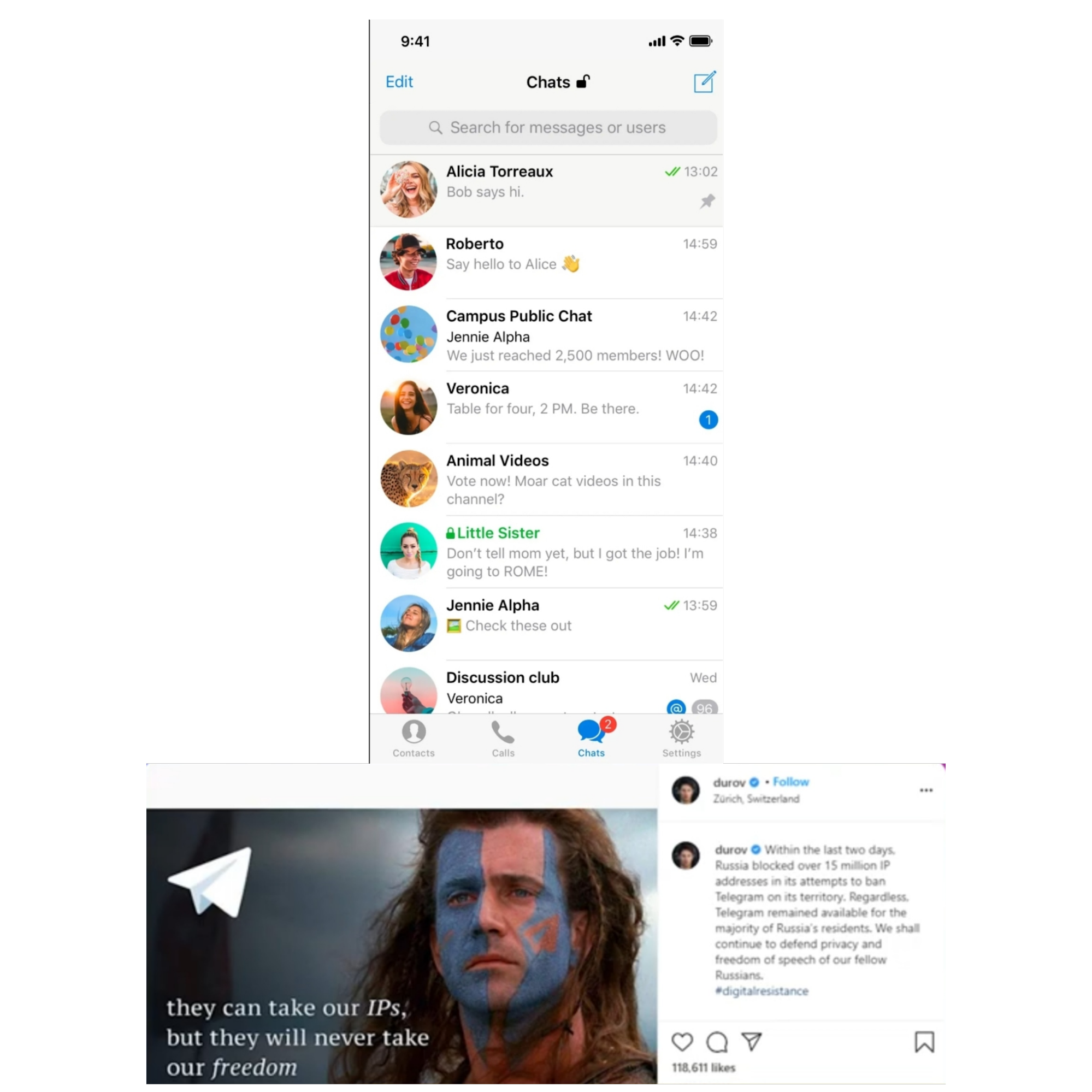
Telegram is the creation of Pavel and Nikolai Durovs. The brothers' previous project was VKontakte, a Russian counterpart of Facebook.
Telegram is the answer to WhatsApp. It started with Pavel Durov's desire. Its code-name was Telegra.ph. He wanted to communicate with his brother in a way that would be free of Russian control. VKontakte was already being monitored. Nikolai designed MTProto, a protocol for mobile devices that became the foundation for Telegram. The brothers worked on the app in secret while the Russian shareholders tried to silence VKontakte.
Telegram's main aspect is its care about user data. It's encrypted in many ways and difficult to reach for any third parties. The founders’ main goal was to fight for free speech, which Russian authorities try to limit.
Pavel Durov raised funds for Telegram thanks to Digital Fortress. It was a company he had set up secretly while he was still at VKontakte.
Durov promoted Telegram through his social media. He used his Instagram account to post about his “war” against the Russian government. Durov had a lot of followers, so it was a successful strategy in promoting Telegram.
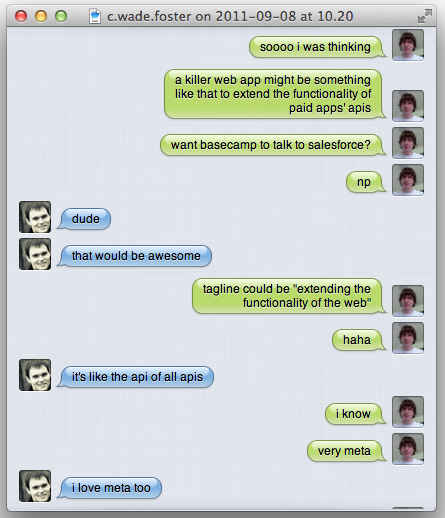

Zapier Beta was full of bugs. The initial prototype was built within 54 hours at Startup Weekend in Columbia.
Wade Foster, Bryan Helming, and Mike Knoop needed people to test their software and give them feedback. Foster went to online tech forums and looked for people interested in apps integration. He posted links and got 10-20 new visitors from each one. About half of that decided to give it a try.
The founders also asked people to pay a one-time fee to test their beta product. They didn't want to make money on beta. They wanted to make Zapier look more “exclusive.” It was $100 from the first few users and then $5-$10 for the rest.
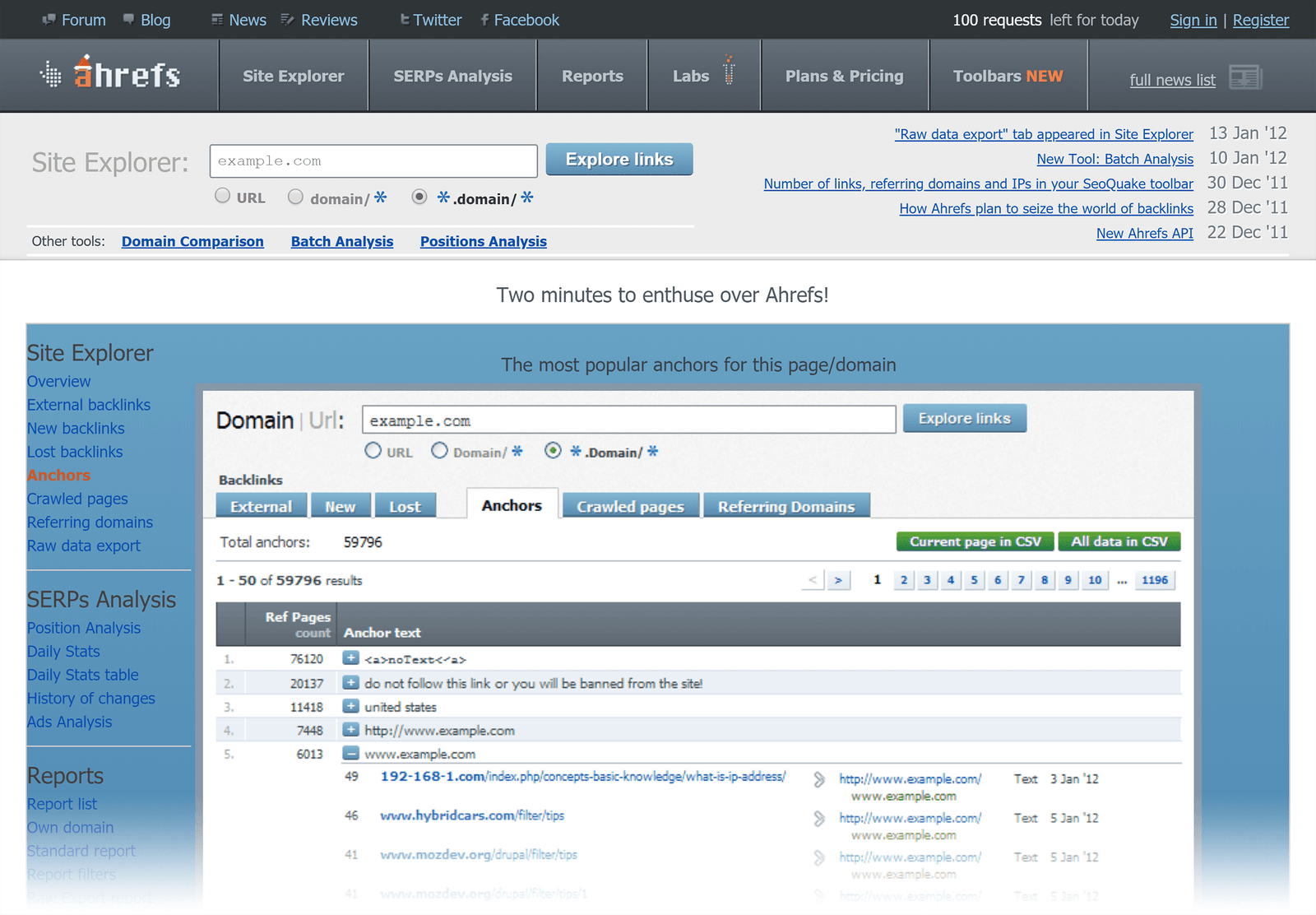
The founder, Dmytro Gerasymenko, set up his first simple online database of links when he was still at school, but he lost all of that due to a server crash. He didn't back up.
He started it all over again after a few years. Site Audit was Ahrefs' only tool at its launch. It was supposed to be just an indexing system and a web crawler.
Ahrefs' team didn't do much marketing. They just posted some ads on forums for SEO specialists and marketers. They got their first users. Those people brought others through word of mouth because the guys had a really cool product of high quality.
Other than the forum ads, in the beginning, Ahrefs had no other adverts or any direct marketing strategies. They focused on their product instead.
They hired Tim Soulo. He became their Head of Marketing. At first, Ahrefs was just a good backlink analytics tool (they stormed that niche), but that wasn't enough. Tim was a great writer. He reworked Ahrefs' UI and focused on their blog. People started telling him the blog made them want to try Ahrefs.
He went hard on the blog explaining how to use Ahrefs to make their SEO work efficiently. He knew what people searched for. He also ran some low-cost Facebook ads.
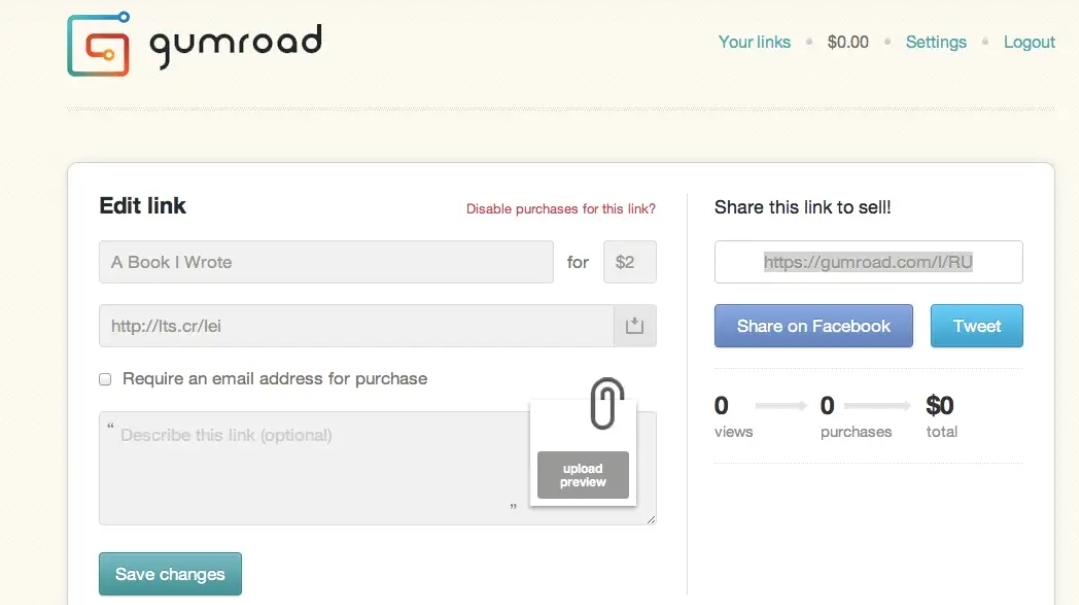
Sahil Lavingia, a teenager from Palo Alto has designed a few apps before. They weren’t successful. Soon, he started playing around with Photoshop. He made a pencil icon for another app.
He didn’t finish that app. He thought that he could still make money on the icon because it took him a few hours to polish it. He thought about following designers on Twitter and putting the icon on a marketplace, but there wasn’t a place for stuff like that.
It took him one weekend to come up with Gumroad. Gumroad was then a single Python file on top of Google App Engine. You uploaded your work, set a price, and then got a shareable link. At first, the payment was a fixed 7.5% + 25¢ from each transaction on Gumroad. Later, it was possible to choose between a few models. People started coming in. They needed it just as Sahil did.
First users came to Gumroad from emails. Sahil sent tons of them. He and his team searched for people potentially interested in Gumroad's services, and then cold-emailed them directly.
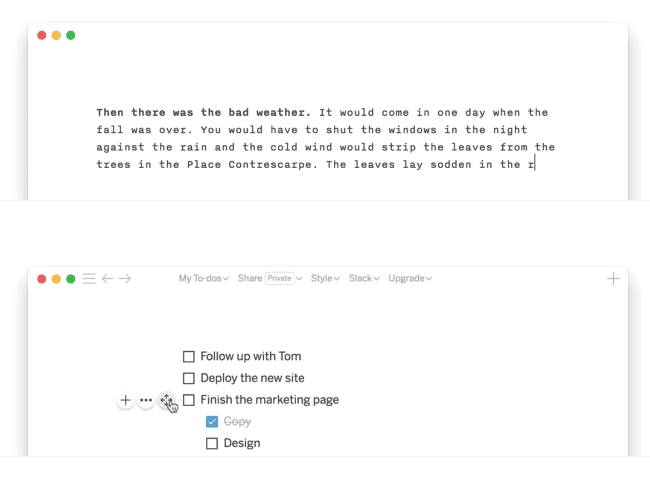
Notion 1.0 UI short GIF presentation from Product Hunt
Ivan Zhao and Simon Last iterated a few times before coming up with the appropriate version of Notion.
Their first, no-code version of the app, kept crashing and died after 2 years.
Later, Ivan asked his mother to lend him $150,000 to fund Notion 1.0. It was an all-in-one app for work. It merged notes, docs, and other important stuff to save time from switching between different apps.
The app was successful, but it didn't satisfy Ivan. He wanted something better, so he began work on Notion 2.0. When it launched in 2018, it was a total bullseye.
They marketed it on Product Hunt, and refused all the investors. Once The Wall Street Journal wrote Notion a review, its popularity boomed. Their team is only 13 people big.
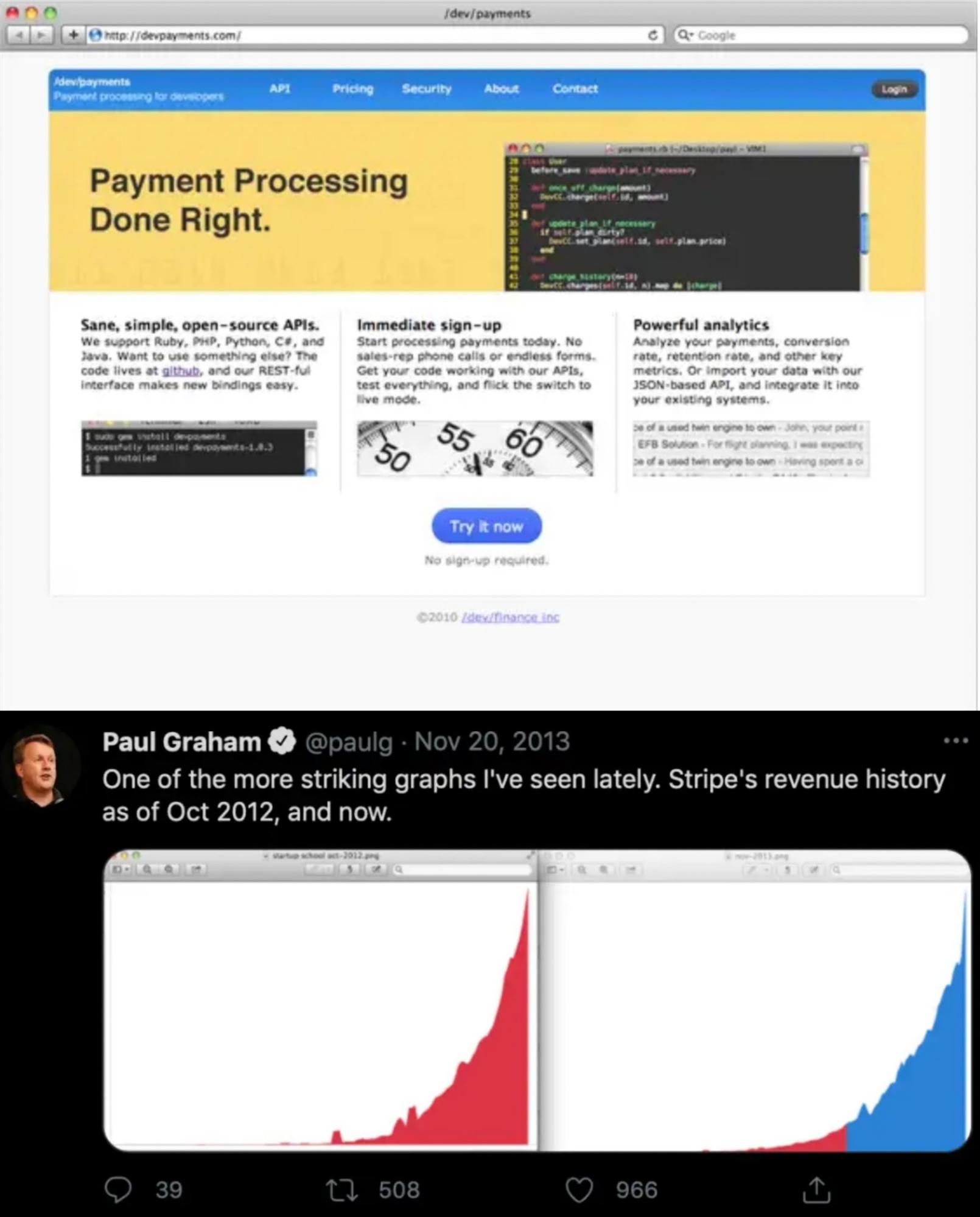
Stripe was born to make payment easier for developers. Other payment services, such as PayPal, didn't focus that much on developers.
Patrick Collison knew Paul Graham from Y Combinator. Collison's previous project, Auctomatic (an online auction management system), was built thanks to YC.
Before Paul and his brother, John, launched Stripe's prototype, it took them 6 months to iterate a lot and ask their friends for feedback. Then, they had a prototype ready in 2 weeks. 280 North was their first customer. It was one of the YC companies.
Graham trusted Patrick with Stripe because Auctomatic was profitable as well. Around $30,000 was enough for Collison to get more traction. /Dev/Payments was the primary name, but it was changed to a much simpler Stripe pretty fast.
Stripe grew mainly through word of mouth. In Patrick Collison's words: "That was surprising to us because it’s a payment system not a social network so it’s not something you’d think would have any virality whatsoever. But it became clear that everything else was so bad and so painful to work with that people actually were selling this to their friends."
Other than that, Paul Graham's activity on his social media channels (mostly Twitter). He put great trust in that project. Stripe was also talked about on the YC blog.
 Solve your competitors problems
Solve your competitors problemsFind the areas where your competitors' products or services suck, and solve these problems.
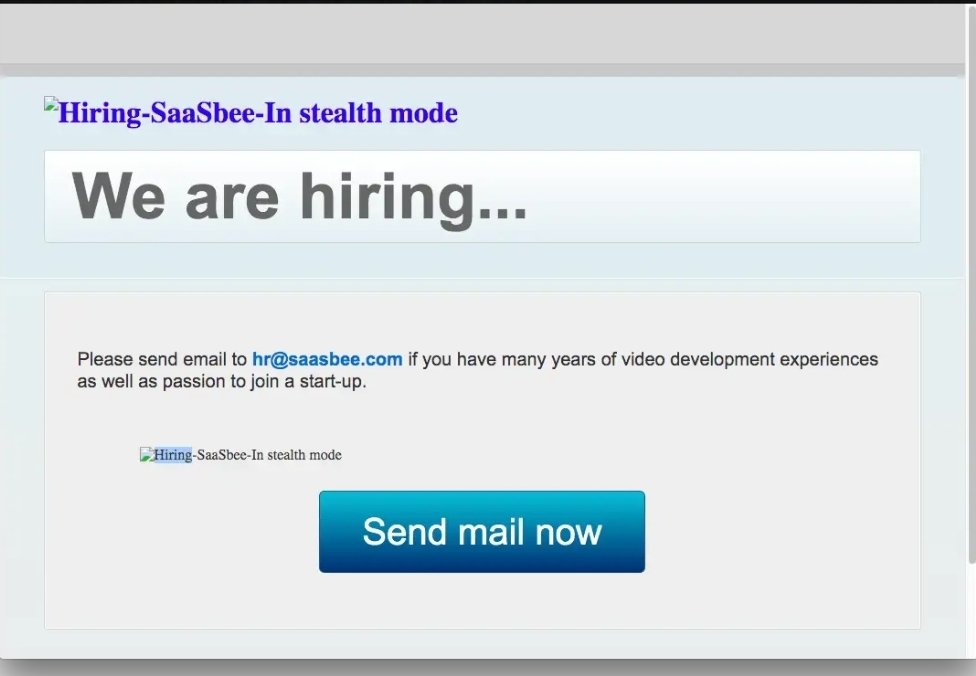
Zoom was founded by Eric Yuan, a former WebEx worker at Cisco, which was a platform for video conferences.
Customers of the company were unhappy with the service quality. Yuan left Cisco together with about 40 other employees and had a plan for his own startup.
He raised around $250,000 from his friends to pay for the people. His project was called Saasbee. The aim was to stand a challenge for video-conference giants, like Skype or Hangouts.
After one year, Saasbee was renamed Zoom. In contrast to their competitors, Zoom was lightweight, stable, and worked even with poor internet connection.
Zoom went public in 2019, and 2020 saw the outbreak of COVID-19. Many people stayed at home to work remotely. That turned them to video conferencing. During the pandemic Zoom's daily downloads increased 30 times. Zoom said that March 2020 saw their user base skyrocketed to 200 million (from 10 million in December 2019).

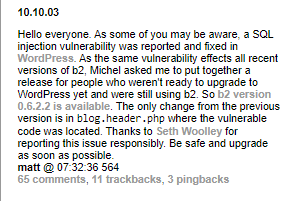
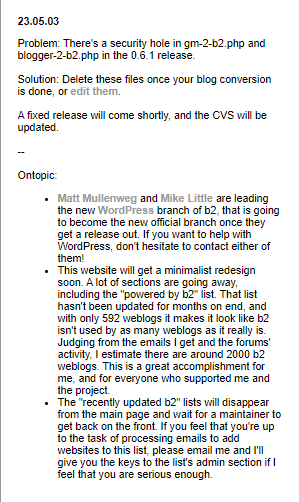
Matt and Michel's posts about WordPress on b2/cafelog website.
WordPress started as a tool for creating blogs. It was built on the code of B2/cafelog, a popular, yet simple blogging tool. B2/cafelog went down without any explanation from its creator.
One of the B2/cafelog's users, Matt Mullenweg, decided to come up with something new and better. He was a programmer, so designing such a tool was a piece of cake for him. When Mike Little saw Mullenweg’s post about his plans, he joined him.
Matt and Mike have been working on WordPress and talked about it on cafelog.com while still working on it. They kept the community updated with their progress. Michel Valdrighi, b2/cafelog’s creator also wrote about the guys’ work before he decided to disappear.
WordPress 1.0 was just as simple as B2/cafelog, but had a few more cool features that made it stand out. For example, it had better UX, more attractive templates, and various style pages.
I'd argue, there's not a single company in the world that keep the same old, version of their business, completely unchanged since the day 1.
You start with the beta version (MVP) then iterate.
As the Reid Hoffman, the founder of LinkedIn, once said "If you are not embarrassed by the first version of your product, you've launched too late".
This section will include companies, that haven't just slightly iterated their business, but have found out the most popular features of their products and have completely pivoted their service according to this feature.
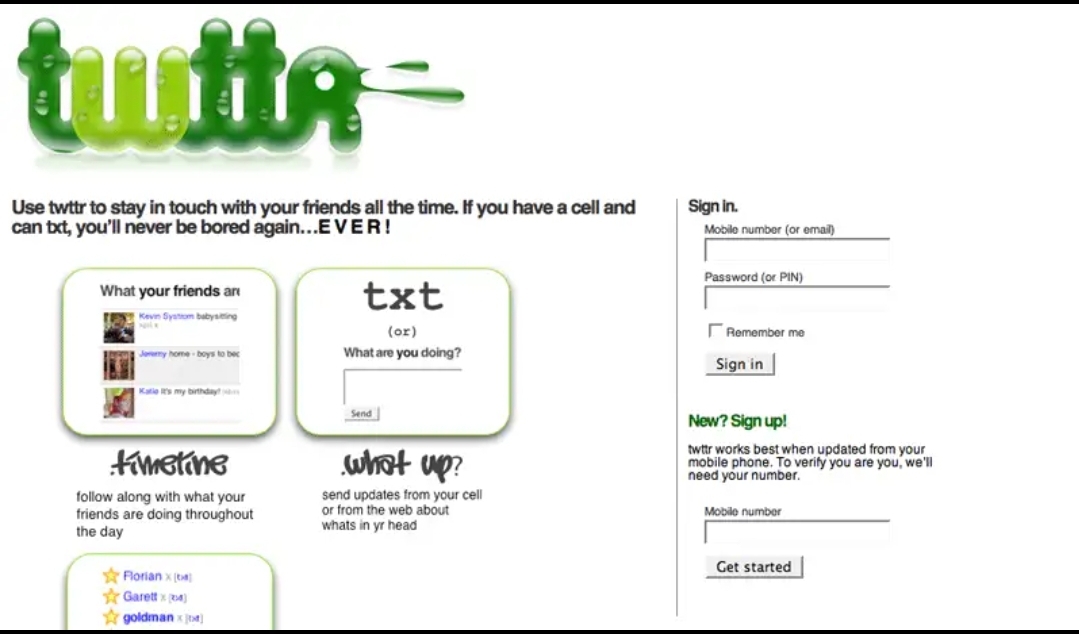
Twitter started as twttr. It was a text messages broadcasting app by people from Odeo.
Odeo was Noah Glass' podcast platform. When Apple launched iTunes, Odeo began to fall rapidly – nobody needed a podcasts-only app. Glass and his team started organizing hackatons to save the business. One of Odeo's workers, Jack Dorsey, came up with the idea of twttr, a new Odeo's product. Glass liked and supported that.
At first, twttr was meant for teamwork and internal communication, but soon media like TechCrunch picked up the trace. It gave twttr its first thousands of users. Once the guys bought the Twitter.com domain, they changed their product's name to Twitter as we know it today.

Groupon was born from The Point, an online fundraising startup founded by Andrew Mason. People donated their money and saw others donating. The progress towards the goals made it more reliable, but that startup was still a failure.
One good thing about it was group deals, and that's when the idea of Groupon was born. Mason's team called hundreds of vendors to get new group deals and put them on their website. The first deal bought (by 20 people) on Groupon was two pizzas for the price of one. The vendor with that deal was placed at Groupon's HQ.
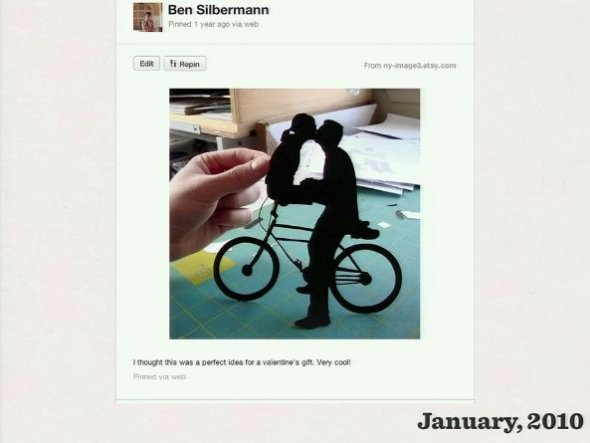
It started as Tote, an app for comparing online stores offers. Despite the funding, the app wasn’t successful, but one feature stood out. The users liked the “Favorite” option that allowed them to save their favorite pics. Later, the app would send push notifications when the saved items would get cheaper.
The app’s founders noted this little fact and decided to build a new app that would allow users to browse pictures and store their favorite ones on their profiles. They also created categories. Their users often searched for products with the use of common category names (“jackets,” “jeans,” and so on).
They were different from other social media apps because they focused on people’s interests – not on their statuses. The founder, Ben Silberman, promoted the app by himself. He would go to coffee shops and other places where people usually meet, and then ask them to check out his new app. He then observed what they liked about it (and what they didn't like). The First 3,000 users appeared within 3 months

First, there was an online multiplayer game, Glitch. It was made by Steward Butterfield and his Tiny Speck company. The game had an internal chat system. It was divided into tabs that worked more like chat rooms. This feature became very popular among the players, but the game itself failed.
Butterfield's team noticed the popularity of the chat system. They decided to make it a separate project - a team communication platform. The tool was originally called Linefeed. They used it as the foundation to build Slack on it. Then, they asked their colleagues and friends from other companies to test the app.
Problems appeared when more users joined Slack, so they needed to tweak it a lot. They announced its public release on Twitter. It was their beta, but they didn’t call it like that officially because people may have lost interest.
Thanks to Butterfield’s network, 8,000 users joined Slack on day one. Butterfield told his friends and colleagues about his new platform. The word-of-mouth power granted Slack’s initial success.
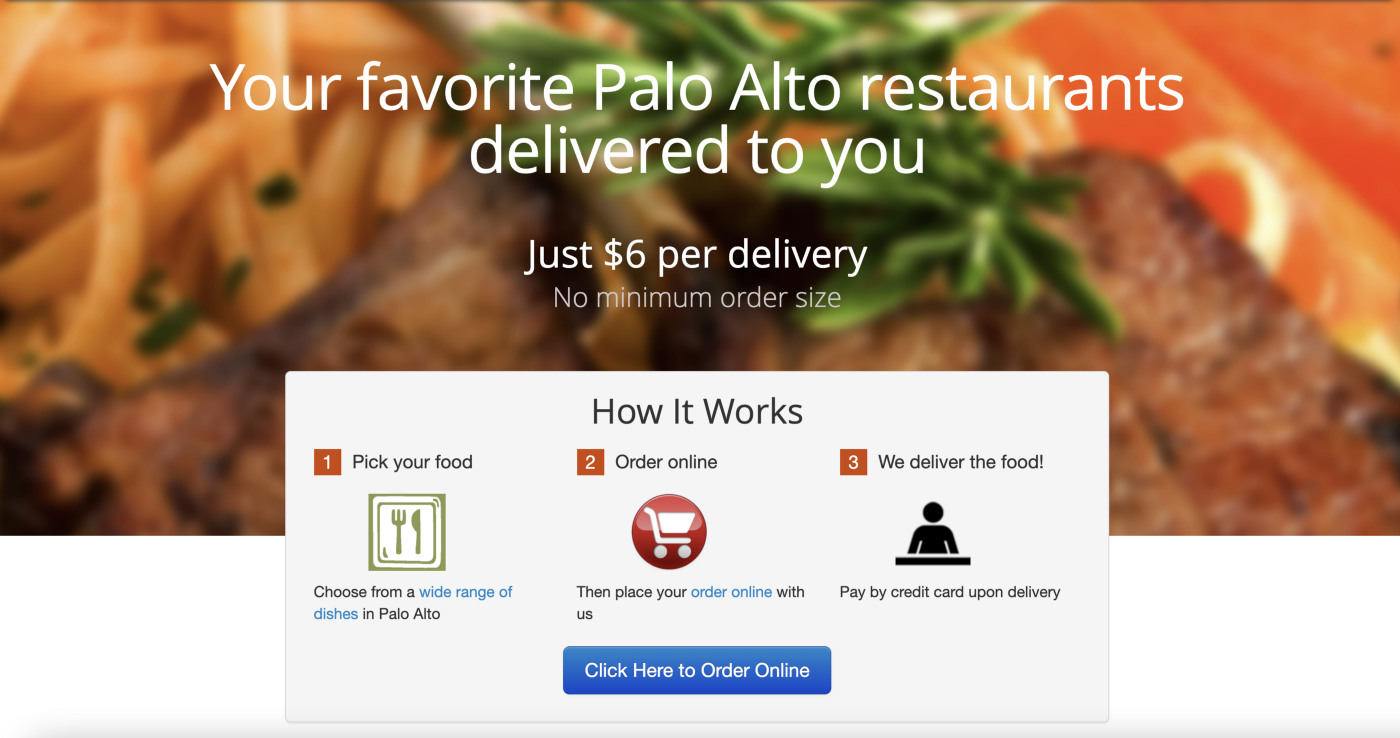
A bunch of friends designed an app for small businesses. They asked a local macaron store manager to test it. It didn’t fit her needs because her only need was to be able to deliver food to the customers. Their app was buggy and had some useless features. Also, no restaurant offered food deliveries in Palo Alto at that time.
The guys interviewed about 200 local stores and restaurants, and the feedback was all the same: problems with deliveries. So, they then tweaked their idea for the startup and set up a page PaloAltoDelivery.com to fill the niche. They focused only on food delivery. Their page had PDF menus copied from various restaurants and the creators’ personal phone numbers. But, they first tested the demand among students.
They printed out some flyers and put them around the Stanford University campus. They changed their name to DoorDash after a few months.
They charged $6 for delivery. They were students and food delivery drivers at the same time. They succeeded because they had their own drivers, while other, similar apps only boosted restaurants’ sales.
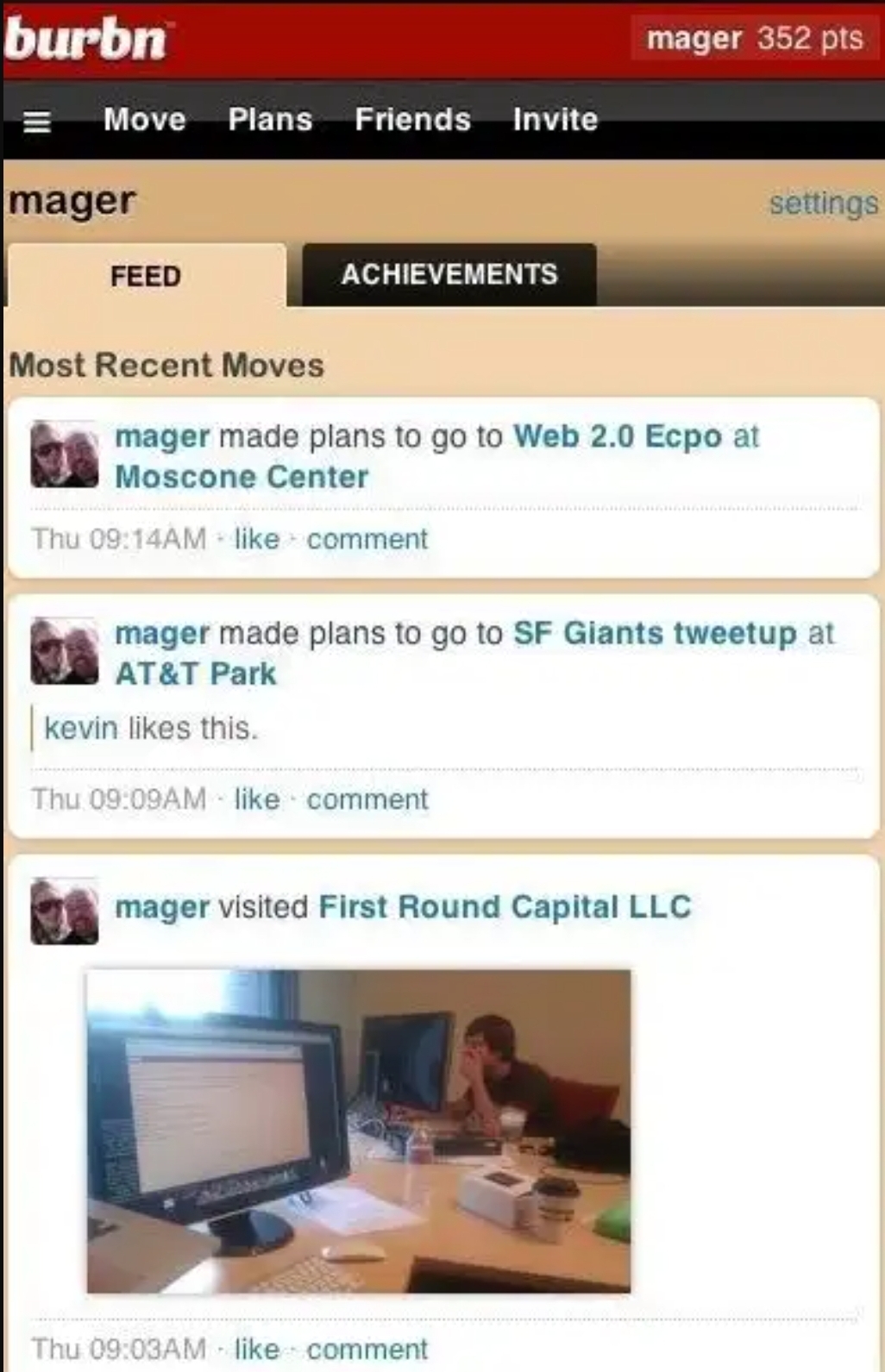
Kevin Systrom interned at Odeo (a company that made Twitter sometime later). He thought about making his own app for photo-sharing and location tagging. There were some social network apps with the checking-in feature. But, they didn't mix it with sharing photos.
Burbn was unique in this, but it wasn't enough to make it popular. Its UI was too complex in comparison to similar apps, but people liked the photo-sharing feature. Systrom decided to remove everything but photo-sharing. He started from scratch.
The creators shared Instagram with friends, tested it a lot, and polished it to perfection before launching. Instagram's key feature was photo-sharing. It became an instant hit on App Store.
25k users downloaded Instagram on the first day. It's probably because Jack Dorsey, the founder of Twitter, was a friend of Systrom, and twitted about Instagram to his 1M followers. Many of them checked it out.
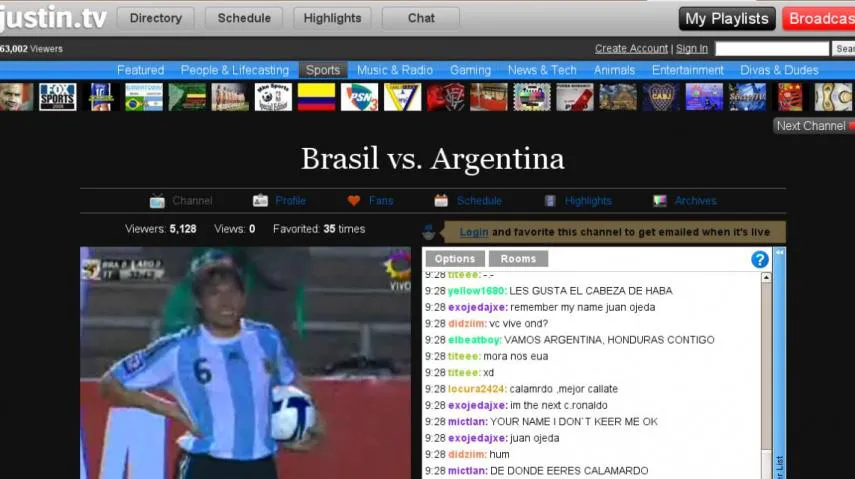
When Twitch started in 2005 as Justin.tv, it was more focused on real-life content rather than games.
Justin.tv was a small platform with user accounts called “channels.” Users could stream by using the “Broadcast” function. The content was divided into many categories. Streaming on Justin.tv was possible on various devices, just like it is now on Twitch.
The platform got its first users thanks to Justin Kan's, the founder, unconventional approach. He livestreamed his life there 24/7. People watching the stream wanted to influence this "spectacle". Just 4 days after launch, viewers had reported an alleged "stabbing" incident in Kan's apartment. Which resulted in police raiding his place. The next day, 6 fire trucks showed up, because someone reported a fire at his apartment.
Justin.tv also received a ton of media coverage, which helped a lot.
The founders noticed that e-sport content and gaming was the fastest-growing category on Justin.tv. They set up a new platform, TwitchTV, just for that. It caught on pretty fast, thanks to the earlier popularity of Justin.tv.
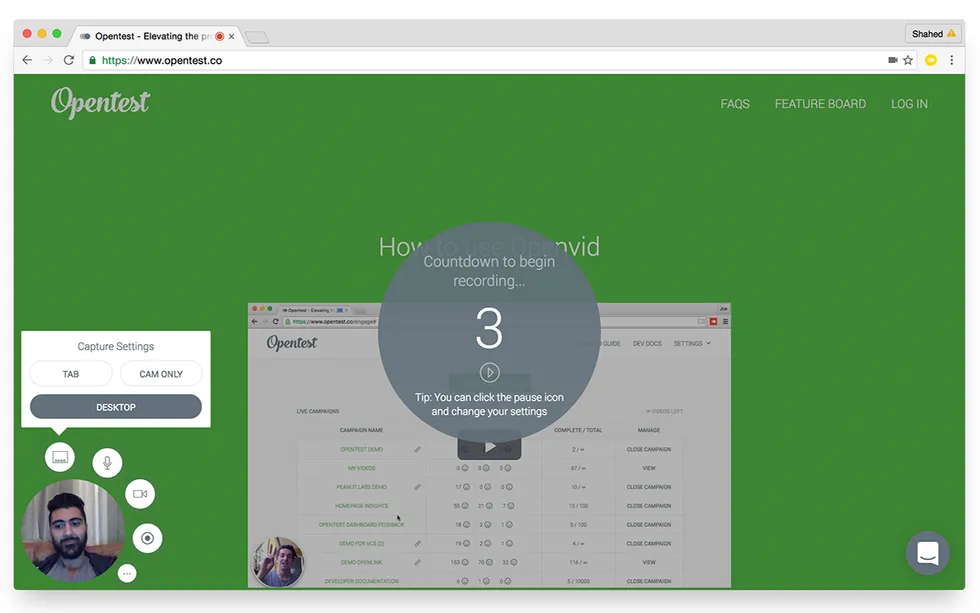
Loom’s MVP was called Openvid, but before that, the founder pivoted twice.
First, there was Opentest. It was a video tool that allowed companies and startups to ask experts for feedback on their products. They could connect online and show them what they were working on.
It wasn’t popular. Nobody wanted to pay for experts’ time. Even Product Hunt didn’t help there. They pivoted and turned their tool into an NPS-like feedback form to embed on companies’ websites. Failed again. One feature was popular - a Chrome extension. You could give instant feedback by recording your screen and your face.
They turned that feature into Openvid - another pivot. They launched Openvid on Product Hunt, got about 2,500 users on day one, and soon launched Openvid 2.0.
Wikipedia helped them to brainstorm a rebranding. The Loom was born.
Many businesses we have today, are just the old concepts presented in a new way. Quite often these old concepts are just adapted to the new structure / technology.
The framework to make old concepts more attractive:

Zappos started as an online shoe store. Nick Swinmurn thought he would try selling shoes online. He set up a website called Shoesite.com and started visiting local shoe stores.
He went to Footwear Etc. in one of California’s malls, and offered them he could buy their shoes and sell them online. They agreed, so he took some pics.
He asked friends and family for funding. He has collected $150,000 this way. He also took a job in Silicon Graphics to save more for his startup. He had problems with getting investors until his attorney told him about Tony Hseih from Venture Frogs. After some talking, Tony gave Nick $500,000. They changed the startup name to Zappos, and the startup moved to Venture Frogs’ HQ.
Zappos didn’t put much into marketing because mass ads weren’t effective in their case. They focused on customer service. They offered free overnight shipping and free returns. Instead of gaining more and more new customers, they made sure to make the old ones stay with them. The customer-oriented approach provided Zappos with excellent word-of-mouth results.
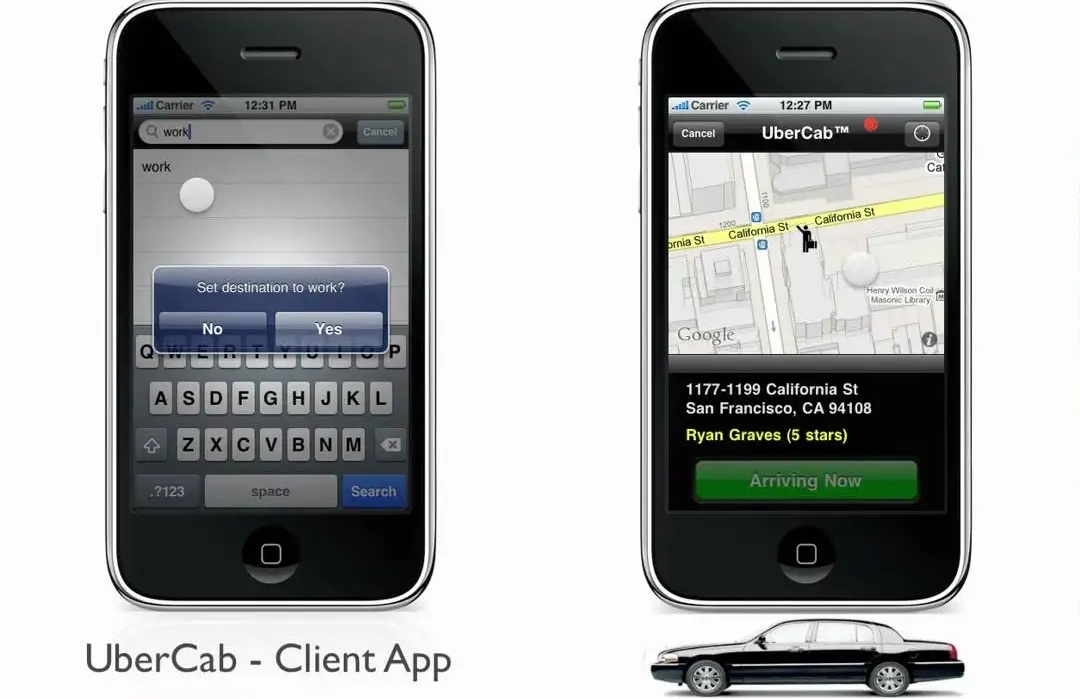
UberCab was founded in May 2010. Garrett Camp and Travis Kalanick had only three cars at that moment. The idea was born on a winter evening when the two couldn't get a cab. They thought that taking a ride with a simple screen tap would be a great thing.
UberCab was Camp's side project. He worked on it between 2009 and 2010. The guys looked for employees on the Internet (e.g. Twitter). The first ride order was placed in San Francisco, Uber's starting place.
In its beginnings, Uber let its users order only a black luxury car for the price of 1.5 times the taxi price. This way, the perceived value of the service was high, and it kickstarted the word of mouth.
Then they recognized the weeks and the weekends with the highest demands on the cab services (Austin’s SXSW Conference, late parties, concerts, sporting events, BBQ deliveries) and offered their services (sometimes even for free). This way they acquired thousands of customers within the shortest possible time periods, with a minimal budget.
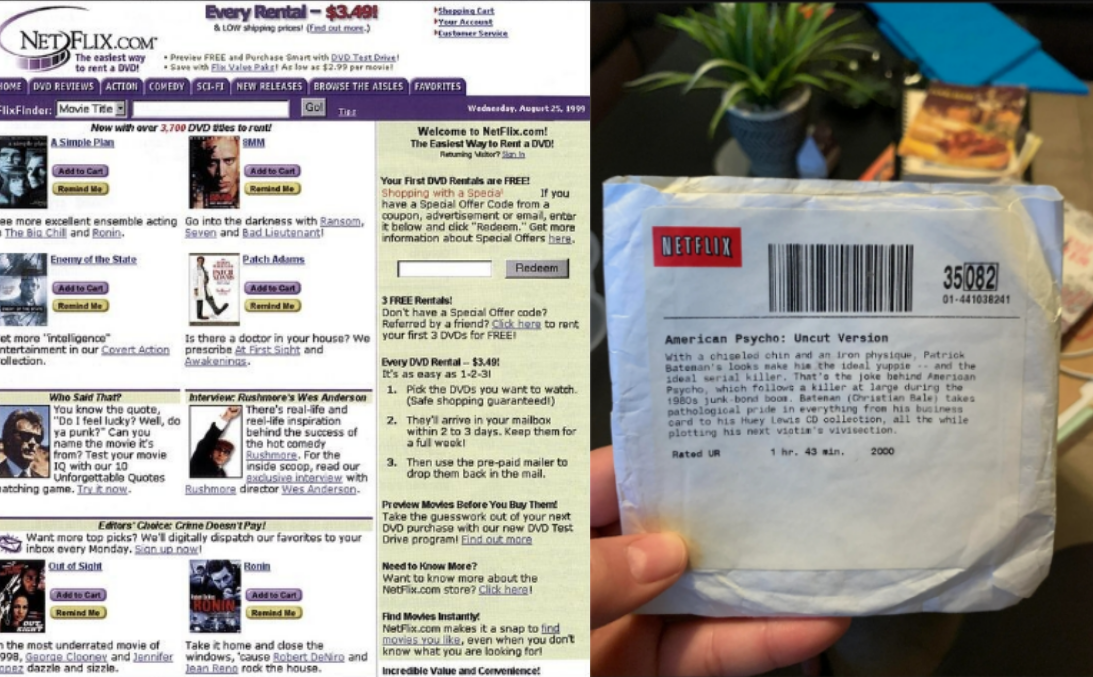
Netflix started as a DVD rental service.
It was called Kibble during its beta. It was sending DVDs with movies to people who ordered them online. The packages contained the movies ordered together with a sleeve for sending the DVDs back. The company paid all the shipping costs.
Before Reed Hastings and Marc Randolph set up the website, Randolph mailed a used CD to Hastings’ house. Reed confirmed the disc came safe and sound, and they knew that it could work.
Ordering movies on Netflix was fully automated. Users who ordered an out-of-stock movie were put into a queue. The business plan was based on a subscription of about $20. It wasn't anything new at that time to rent DVDs with movies, but Netflix let its users do it online. The process was very simple.
Reed gave $1.9 million as the angel investor. Marc raised another $100,000. He asked some investors to give him $25,000 each. Some of them agreed, and the last investor was Marc's mother.
They needed to create a demand for renting DVDs. Marc went to the Consumer Electronics Show in Las Vegas to talk to DVD manufacturers – Sony, Toshiba, and Panasonic. DVDs weren’t easily available yet, so customers were afraid of buying DVD players.
Marc offered the manufacturers a simple deal: customers in exchange for an increase in sales of their devices. Netflix would make people sure that buying DVD players would not be a waste of money - each Toshiba's DvD player would include a free coupons for Netflix. Toshiba accepted that offer.
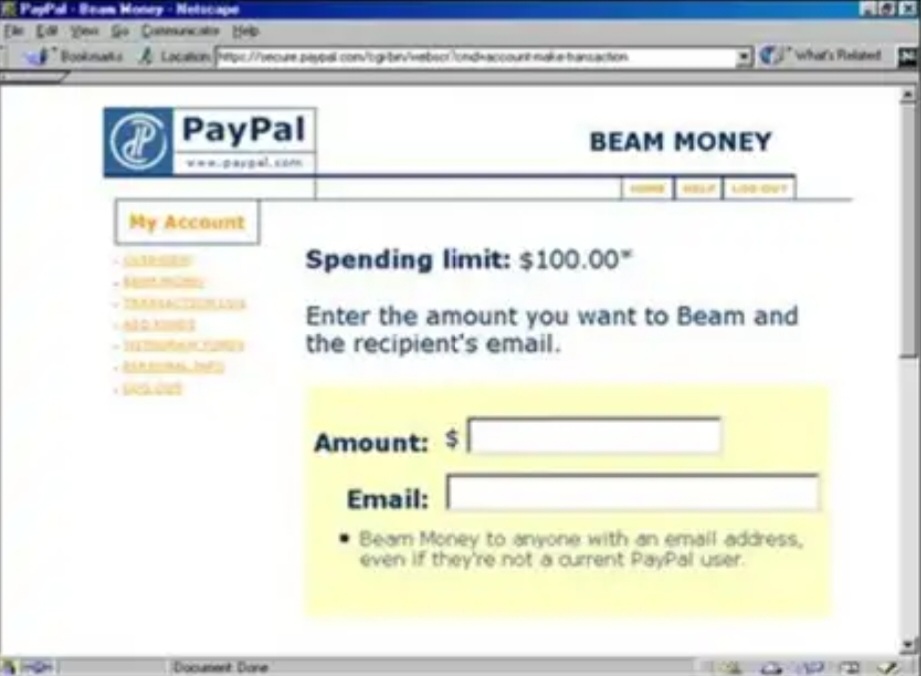
The idea for PayPal was basically a service to make money transfers through email. It was established in 1999 as Confinity – a mobile payment security company by Max Levchin, Peter Thiel, and Luke Nosek.
It targeted small businesses, offering online banking services and faster transactions. They hired their friends first. PayPal was their flagship product.
At the earliest functioning version, PayPal let you send money to someone if you knew their email. You could do it even if they didn't have a PayPal account. Later, PayPal transformed into a full-blown digital wallet.
When PayPal appeared on eBay, the team made bots. Their target were eBay Power Sellers – the top 20,000 merchants on the platform. The bots were buying stuff there and insisted on paying via PayPal. eBay sellers got interested in the service because it looked like there was an increasing demand for it.
This marketing stunt turned into 33% market share after just 3 months!
After the merger, between Confinity and Elon Musk's X.com, Musk's company changed the name to PayPal. Confinity got phased out.
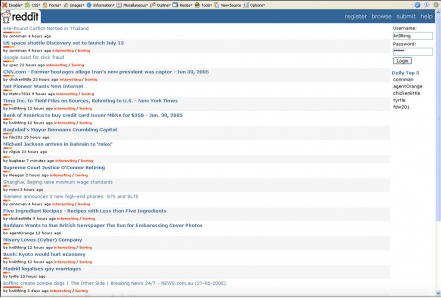
Reddit (comes from “Read It”) was founded by two University of Virginia students, Steve Huffman and Alexis Ohanian. They’ve signed up for Paul Graham’s Y Combinator, an incubator for smaller startups. The guys wanted to make an app for ordering sandwiches, but Graham told them to make a news-like “board” with links.
People were supposed to put some links to other websites, and others could mark those links as interesting or not interesting - that’s all. They struggled with getting their first users, so they came up with a shady solution. They created fake accounts and started faking traffic by posting links. Reddit had no subreddits until real users began coming in. The fake accounts got phased out over time.
At the beginning, Reddit’s creators put all users in one place to create a “feeling” that the platform is “crowded”. One group with 100 users looks much better than a group with 10 people.
Very early on Reddit was a censorship-free platform. One of the most popular subreddits was NSFW which accounted for around 10% of the traffic.
3 years after the launch, Reddit users could submit their own subreddits. This feature brought a steady growth to the platform
 Make old concepts simpler
Make old concepts simplerOne of the ways to make your product stand out is to reduce the friction in the UX.
In overall, make your customer's life easier.

Before Canva, there was Fusion Books.
It was Melanie Perkins and Cliff Obrecht’s project to help schools design high-quality yearbooks for students. During her studies, Perkins made additional money by teaching other students about design. She saw they needed a simple graphic design tool – printing flyers or posters was problematic. Her mom was a teacher and had a lot of work with the school's yearbooks. That inspired Perkins to create a tool for designing yearbooks.
She couldn't code, so she paid someone who could. She borrowed money from friends and hired freelancers. They made her a website. Students could work there together to design their own yearbooks. Together with Obrecht, Perkins would print them and deliver them to schools. Her mother's living room was their office. Obrecht cold-called schools to pitch the idea of Fusion Books. He changed his voice when the schools wanted to speak with the project manager. They reached 400 schools. They started from the local ones. They even sent some free samples of the designs. Perkins left her studies to focus on Fusion Books.
To promote Canva, Perkins kept going to as many conferences and meet-ups as possible. She attended conferences for bloggers, designers, and social media marketers. She pitched Canva to the attendees.
She and Obrecht also reached out to graphic design influencers. They asked them to talk about Canva, so the influencers recommended it to their followers.
During that time, Perkins tried to raise funds and look for investors for Canva. Up to this day, Canva and Fusion Books operate separately.
Perkins and Obrecht built a community around Canva and created a waitlist. It was all before Canva even started.
50,000 users have signed up on their waitlist before Canva's public launch. It got to 150,000 pretty fast thanks to a tech influencer, Guy Kawasaki. One of Kawasaki’s employees was using Canva and made him get interested in the app.
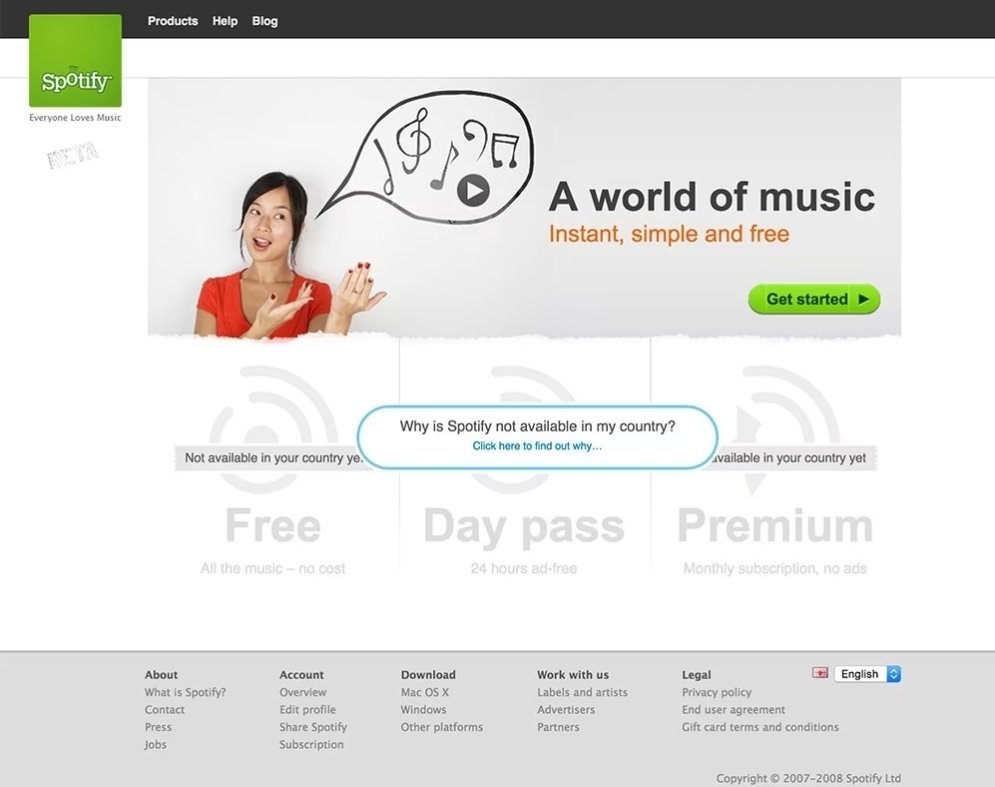
Spotify AB was Spotify's prototype. Daniel Ek and Martin Lorentzo wanted to make the platform as lightweight and intuitive as possible. They aimed at fighting piracy in the music market.
The only music alternative for illegal Napster was iTunes, with $2 per single song. Ek and Lorentzo wanted to be in the middle. They focused on reducing latency, so that all the songs would be played with no waiting time – just like right from a hard drive.
They contacted music bloggers in Sweden and asked them to beta-test Spotify. The testers loved it because of its quality, and then they spread the word. Spotify became an instant jackpot in the music industry.
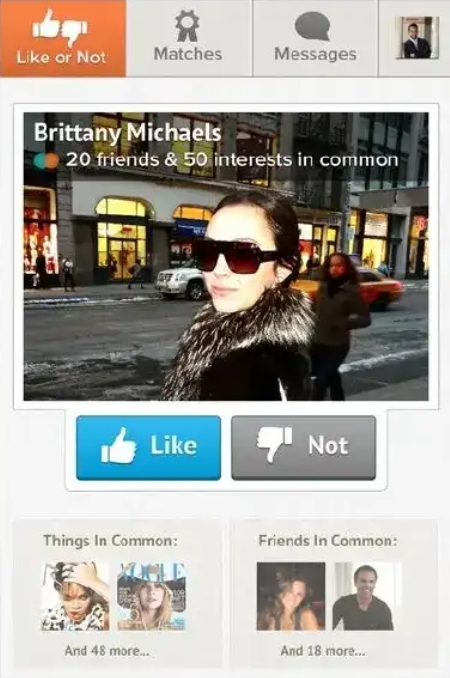
Tinder was originally called Matchbox. It wasn't catchy enough. It was changed to “Tinder” to bring connotations of fire and warmth.
The founders promoted Tinder on the University of Southern California campus. It was a great audience for a mobile dating app. First, they collected 500 students' phone numbers and texted them about Tinder.
Then, they asked one girl if they could turn her birthday party into a “Tinder party” because she had a bus ordered by Justin Mateen's brother. Mateen was one of Tinder's co-founders. The girl agreed. They called it a Tinder party and made one requirement for their participants: download Tinder to enter the bus. Everyone had to show the app on their phones. 400 people did this.
Later, the founders visited any fraternity and sorority they could and talked about Tinder there. That gave another 100s users night after night. They even talked to people on the street and hit coffee shops. Swiping profiles left and right made it more like a social game, so students loved it.
 Challenge the status quo
Challenge the status quoThe world never stops. Things we took for granted 10 years ago, don't matter anymore. Life is a constant change and some concepts are meant to be disrupted.
When everyone Zig, you Zag. That's how you stand out.


Evan Spiegel and Bobby Murphy created an app for sending disappearing messages, thereby disrupting the forever content. It was called Picaboo. They marketed it as an app for sexting, but it was still not popular. They tried reaching out to journalists and handing out flyers about their app, but it didn't work.
Spiegel put special care into the logo. He browsed many apps popular at that time, but none had yellow in their logo. He came up with an idea for a little, white ghost on a yellow background to refer to the feature of disappearing messages. He drew the Picaboo logo on his computer.
They changed the name to Snapchat because people might have mistaken Picaboo for other apps on AppStore. They targeted young people. Murphy learned iOS and coded Snapchat for it.
At first, Snapchat's user count was 127. Those were all the founders' friends. Later, Spiegel's mother told her niece about the app. The girl was a high school student and spread the word. Snapchat became a cool app for sending disappearing cheat notes for exams, and its popularity boomed. The app grew from 127 users to 30k in 2 months.
If there's an already established niche with a lot of active people, sooner or later someone will create a place for it.
OnlyFans - pay a subscription fee to get access to the exclusive content of your idols (celebrities, stars). The founder, Tim Stokely, observed a trend in a demand for adult content on platforms such as Reddit, Instagram, and Snapchat. Adult industry performers were selling X-rated stuff illegally there.
Tim got a loan from his father to found OnlyFans.com. He also helped Tim with his earlier startup, Customs4U. It was a website with custom videos on demand. First OnlyFans creators came to the platform from Customs4U. Stokely reached out to (through social media) porn influencers and encouraged them to move to OnlyFans.
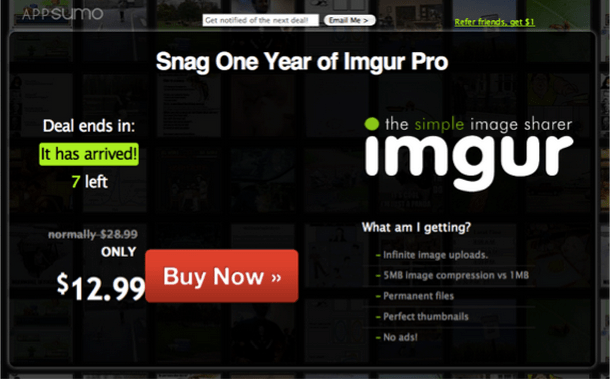
Noah Kegan says he built AppSumo for $50. He wanted to create a website with discounts for premium services on various platforms. He started browsing the net and stumbled upon Reddit.
Redditors were posting a lot of links with Imgur pictures from Imgur Pro accounts. Kegan spotted an opportunity. He wrote an email to Imgur’s CEO, and asked to make a deal. The man agreed. Kegan reached out to one of Reddit's CEOs. He cold-emailed him to get their permission for AppSumo's ad on Reddit. Kegan found a web developer. He made him two ads for the Imgur deal: one to put on Reddit, and then a better one to include on Imgur.
Imgur’s founder took $7 from every subscription plan bought through AppSumo (AppSumo's price was $12.99), and the developer worked for $12 per hour. Kegan emailed people who bought the Imgur Pro accounts to send them individual registration codes.

LinkedIn started in late 2002 by Reid Hoffman, but the site was officially launched in 2003. He had been working at PayPal, and before that, he had Socialnet (online dating with interest-based search for people).
Socialnet was a failure. LinkedIn was created because Hoffman thought about a place for business networking. Something like Socialnet, but focused on jobs.
LinkedIn was launched six months after the start of its development. There were 13 people first. They invited another 112 to join the platform, and the chain reaction began. At first, the team focused on IT people they knew. They targeted mainly Silicon Valley. High-profile individuals stood for the “auto-promotion” of the new social network for professional connections.
By the end of 2003, LinkedIn had only 200-250 people. It was all personal networking. Hoffman and his team asked friends to join. They also asked their friends. Reid kept adding new features. When it launched, you needed to know someone's email to send a friend request.
Then, LinkedIn started targeting small businesses. New features appeared (creating groups and uploading contacts from address books). Networking got much easier. (Later on, LinkedIn exploited the feature to the maximum. When it got access to your email contacts list, it spammed everyone in it, multiple times. They got even sued for that.)
That gave a huge increase in the number of users by the end of 2004.
LinkedIn used aggressive contact importing with the use of email lists. The platform browsed through users’ contacts and sent invitations. The team has even built an Outlook plugin for that.
After a few years, LinkedIn introduced two important growth hacking things: SEO for profiles and the recommendation system. The first made popular profiles pop up in Google searches. Recommendations created a loop of invitations via professional experiences. LinkedIn started suggesting “People you may know” after scanning your mutual background (past companies you’ve been working at, and so on)
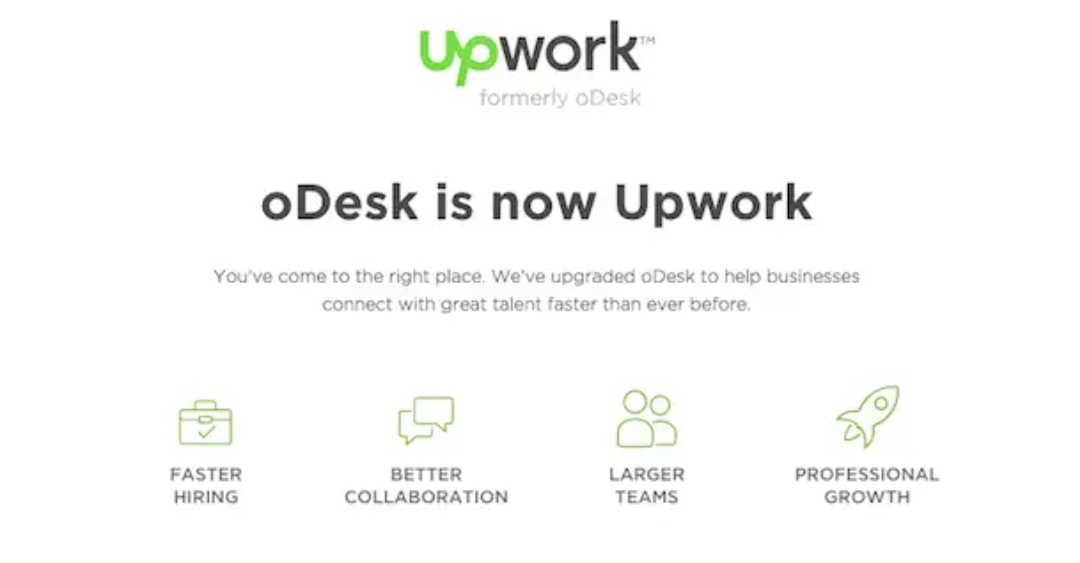
In 2003, Odysseas Tsatalos and Stratis Karamanlakis, wanted to work together despite the distance between them (one in Greece, the other in the USA). They came up with oDesk.
It was a platform that helped companies connect with potential contractors and workers. At first, it was a staffing firm. The team would manually do all the matching between the companies and the potential employees. Then, it became a marketplace for remote work.
So how did oDesk get it's first users? They solved the chicken & an egg problem by figuring out on which group should they focus on first. They choosed the clients paying for the job to be done, because they would attract the freelancers. They bought ads on Techcrunch. Once they got the clients, they keep them for as long as they could.
Then with clients, they got a lot of freelancers - at that point, more than 5,000 per day, organically. They were coming because oDesk had the most jobs.
Later, oDesk got merged with Elance (a similar, but smaller platform). The Elance-oDesk merger got rebranded to Upwork. It was a completely new thing, but basically, Upwork was just a better oDesk. Upwork encouraged Elance users to move to the new platform by giving incentives. Soon, Elance got phased out entirely.
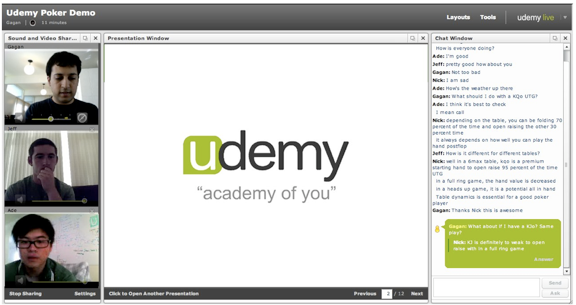
Udemy started in 2007 as a software for a live virtual classroom. 3 years later Udemy was officialy launched. Udemy wasn’t too popular yet so there was courses on the platform. The founders decided to make their own one. Their course was called “Raising Capital for Startups.”
Gagan Biyani (the co-founder) had hosted a conference with Udemy’s investors and used its fragments as his course’s content. The video contained the speakers’ speeches and their slides. That course generated $30,000.
Then, Udemy’s team used it as their case study to lure instructors. Gagan outsourced people via oDesk. They researched stuff and looked for potential instructors on the web for $3 per hour.
The data miners searched phrases people could search when they wanted to learn something (“learning Python,” and so on). They emailed the authors of the sites they founded. Hundreds responded. Later, Udemy emailed instructors who hadn’t finished creating their courses on the platform to offer them a discount. That encouraged a lot of instructors to come back to the platform and finish what they started.
Udemy succeded because their stuff went above and beyond to make creators' experience as seamless as it was possible. They did everything for them to get their course on the platform.
 Niche down
Niche downDisrupt the currently existing niche platform by niching it even further down.

When Evan Williams was founding Medium, there was no place where people could write longer posts. Previously, Evan had co-founded Twitter.
He noticed the demand for longer writing as Twitter limited the length of posts to 140 characters. Medium was supposed to be something between Pinterest and Twitter. Its unique feature was dividing the content into “Collections.
At the beginning, Medium was niched down to strictly entrepreneurial content.
Medium also used the invite-only strategy. Everyone could read the content, but only the selected few could publish. Among these publishers were quite influential personas coming from Evan's network. One of which was Barack Obama.
At the beginning the algorithm was also less strict, which resulted in controversies around some content Medium. And as we know, controversy brings the eyeballs.
[link]
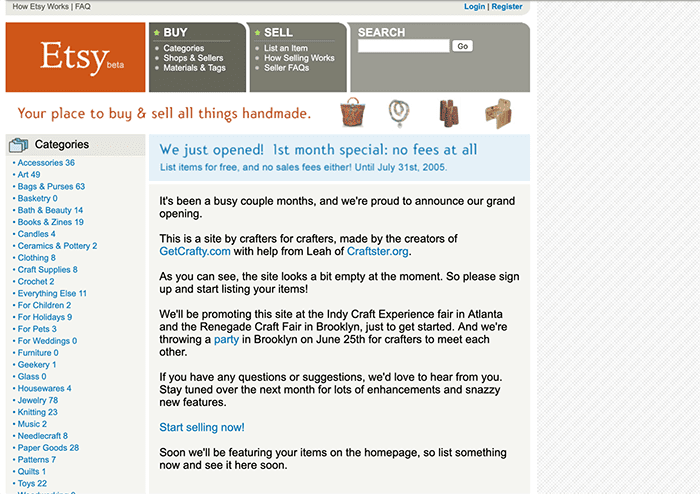
Rob Kalim had a woodworking talent. He crafted a PC encased in wood. There was no place for things like that. He thought he could create one. He called it Etsy because he wanted it to sound unique.
It was supposed to be a marketplace for people like him – artisans and craftspeople – and their works. Chris Maguire and Haim Schoppik joined Kalim to spend six weeks working on Etsy 24/7. The first version of the website was born in Kalim’s apartment in Brooklyn.
Sarah Woodson (now founder of Downing Pottery) was Etsy's first local seller of handmade mugs. The guys kept adding more user-friendly tools to Etsy to attract more sellers. They visited many craft fairs all around the US to promote Etsy.
They also allowed craftspeople to tag a craft fair or event they took part in. It allowed artisans and shops to connect with others. The creators also promoted Etsy on their social media. Soon, Etsy got a hipster-like reputation as a cool place for handmade stuff.
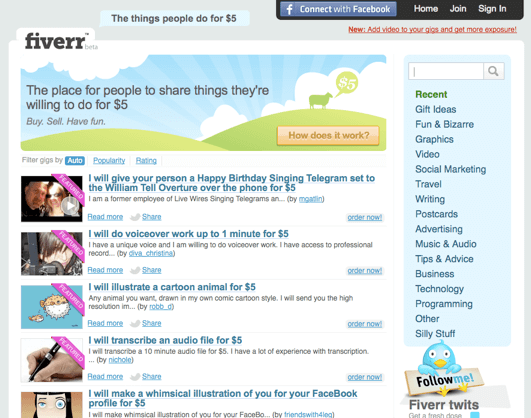
Fiverr's founder, Micha Kaufman, had a small but annoying task to do. He needed to copy a chart from MS Word to MS Excel. It was too small to make a contract with a freelancer but big enough to be time-consuming.
The founder thought that there should be a place for such minor tasks. The idea for Fiverr was born. In the beginning, there was a fixed price of $5 for each task published (each service offer was called “gig”). Right after launch, there was only Kaufman's gig. He offered pitch reviews.
His and Shai Wininger’s (the co-founder) friends told their friends, and the thing got popular soon enough. Fiverr grew mainly through word of mouth. Micha and Shai hit the market when unemployment began increasing among the people they knew. It was all because of the financial crisis at that time.
They wanted to test it directly with their target audience - people who needed to earn some money - so they skipped looking for investors. They hit straight to their closest friends and relatives.
After some criticism from people, the fixed $5 price for gigs was later changed to any value up to $500. The platform saw more and more professionals who didn't agree to offer their services for such a small fee.
Market you sell to is the most important factor of your business. Even more important than your product.
When the market is hungry, people are begging for your product. It doesn't even need to be great. It just has to basically work.
In a terrible market, you can have the best product in the world. But it doesn't matter because none is going to buy it.
A fast-growing market is a great market on steroids. People are begging for your product and the number of those people is rapidly increasing.
And if you're fast enough, you can even establish a First-Mover Advantage in the market.


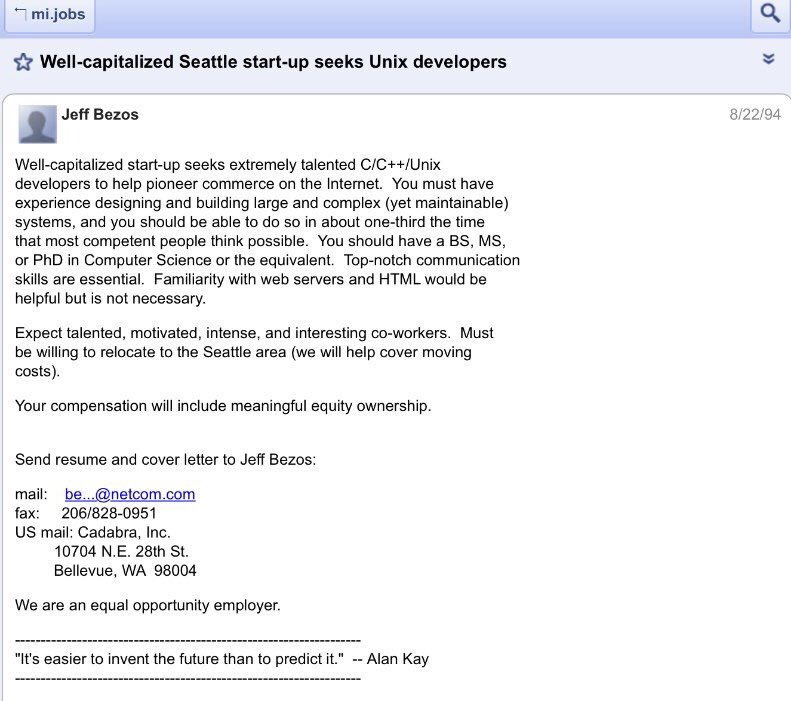
In 1994 Jeff Bezos came across statistics showing the web usage was growing at 2,300% a year. He didn't just hop on the bandwagon. Te took time to find a business plan that made sense in the context of that growth
He made a list of 20 different categories. He thought especially about music and books. He chose books because the market was huge (about 3 million books worldwide active at any given time). He started in his garage with the money he borrowed $300k from his parents. He set up a simple webpage.
He came up with the name “Amazon” because website listings like Yahoo (which was THE INTERNET portal at the time) were organized alphabetically. At first, he thought about “Cadabra” but a name with “A” would pop up earlier on the list.
Bezos used various domains (e.g. 2millionbooks.com) and referrals from lots of “Under Construction” Geocities web sites to drive traffic to Amazon. You couldn't find Amazon was behind these website, until you dig deeper.
One of the biggest source of traffic for Amazon was their Associates program. People would get the % of any sale if you put an Amazon referral link on your website. THOUSANDS of websites joined. It was A LOT at that time. Not even MySpace existed yet. The audience was large, but focused on a few portals.
When he needed to stock, he ordered books from other stores, like Baker & Taylor. He and his team had one problem. The minimal number of books in one order was 10. It was too expensive. They usually needed only one book, but they found a workaround. They always ordered the book they wanted + 9 copies of a book about lichens that was constantly out of stock. The store would send that particular book and a note saying sorry for not sending the 9 books about lichens.
Amazon started generating profits after five years after its launch. This was because they put everything they got into the company’s growth.
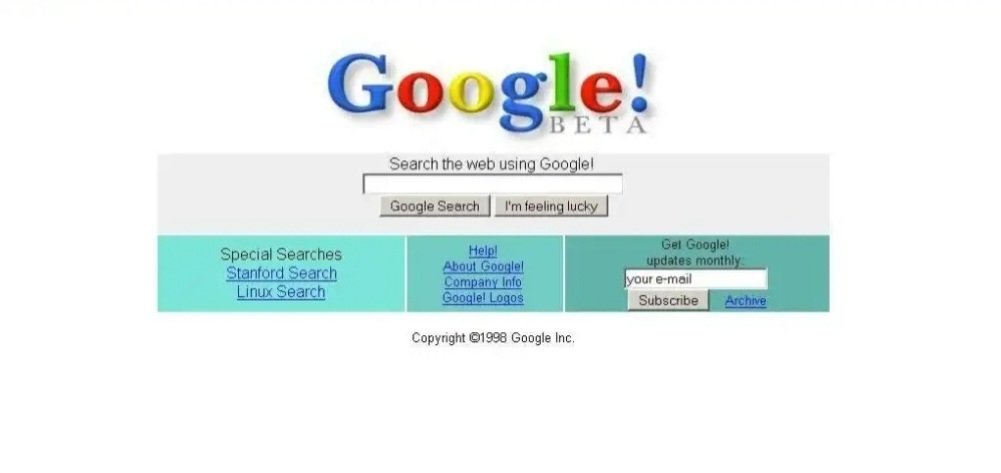
Larry Page and Sergey Brin's at first created the BackRub - Google's precursor. BackRub was Page's research project at Stanford University. It used the university's domain.
The guys used their own algorithm (PageRank) for rating sites by their backlinks to design BackRub. Search engines were more focused on keywords, not on backlinks at that time.
Later, they changed their search engine's name to Google, and the domain was called google.stanford.edu. The company's first office was at a garage they were renting for $1.700 monthly. They set up the Google.com domain there.
Their search engine got good reviews and beat the competition. It was more innovative and gave better results.
Google grew through word of mouth. Also, in the early days, Google let companies pay for placement. The more they paid, the higher they were in the search results.
Later, Google managed to strike deals with Yahoo, Netscape, and AOL. For every 1k queries, Google got $8-$10. Google was underestimated by its competitors, and that gave it much advantage.


Before Coinbase, there was Bitbank, and sending Bitcoin over emails.
Brian Armstrong got interested in Bitcoin. He was reading a lot about it, and he was tracking events related to Bitcoin. He learned that no Bitcoin online wallet was available then. He and his friend created an Android-based open-source Bitcoin wallet.
Armstrong promoted it on Tumblr, Hacker News, and Reddit (he offered 0.1 BTC for a feedback). This got them 15k downloads in 2 weeks plus media coverage.
They also cold emailed people like Garry Tan, stating in the email, that he has received 0.05 BTC. He just needed to create an account to claim it.
A few months later, Armstrong met Ben Reeves from Blockchain.com, they created Coinbase Beta.
It was fully functional and had basic features: transactions, withdrawals and deposits, and checking account balance. Soon, there was a site, a blog, and funds from Y Combinator.
Get your
"oh sh*t, this might work for us!"
moment in the next 5 minutes
In the first email:
Other than that:
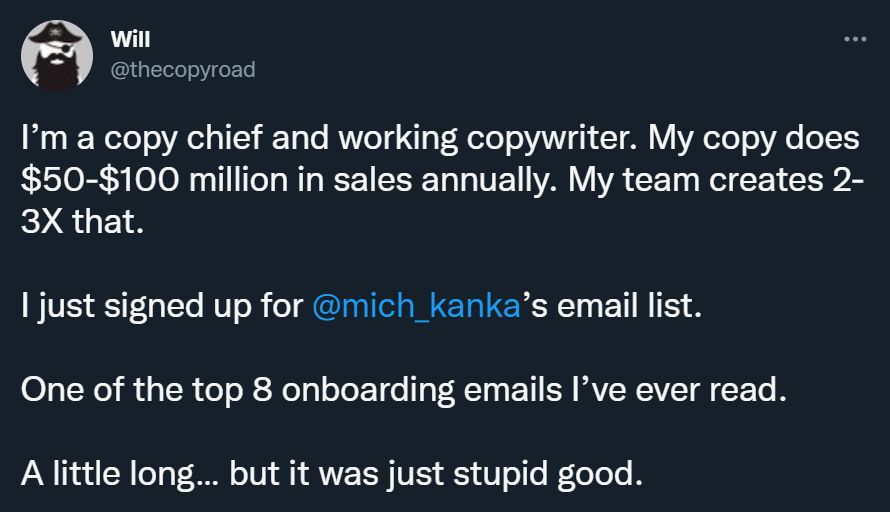
(You won't find it anywhere else)
Explore Cognitive Biases in Marketing